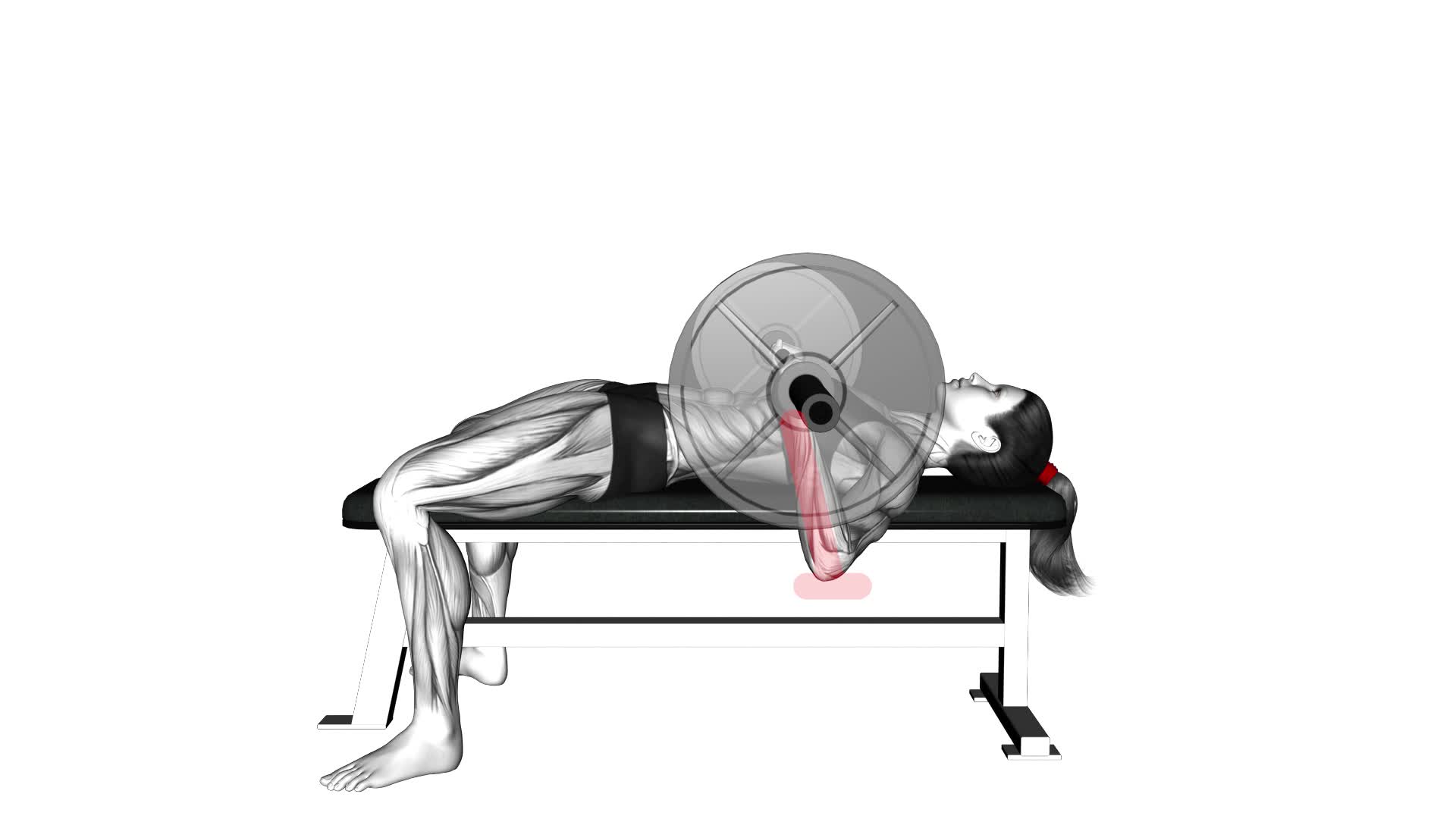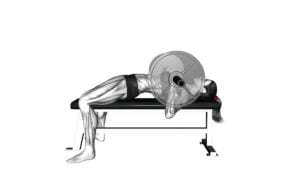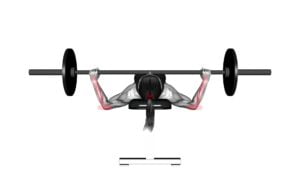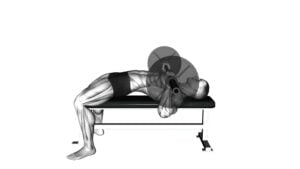Barbell Chest Bench Press – Forearms (WRONG RIGHT) (female) – Video Exercise Guide & Tips

Are you struggling with your barbell chest bench press? Do you want to engage your forearms correctly to maximize your workout?
Watch This Exercise Video
In this article, we will guide you through the common mistakes to avoid and teach you the correct technique for engaging your forearms. Whether you're a female fitness enthusiast or just starting out, we've got you covered.
Watch our video exercise guide and discover the benefits of proper forearm engagement.
Get ready to improve your bench press game!
Key Takeaways
- Neglecting proper engagement of forearms during the Barbell Chest Bench Press can lead to missed benefits and potential instability.
- Gripping the barbell tightly and maintaining proper wrist alignment is crucial for engaging the forearms and promoting stability.
- Incorporating specific forearm exercises, such as wrist curls or farmer's walks, can help strengthen forearms and improve grip strength.
- Engaging the forearms during the Barbell Chest Bench Press improves grip strength, distributes load evenly, enhances performance, and reduces the risk of imbalances and injuries.
Common Mistakes in Barbell Chest Bench Press
Avoid these common mistakes in the Barbell Chest Bench Press to maximize your results and minimize the risk of injury.
One common mistake is neglecting the proper engagement of your forearms during the exercise. Many people focus solely on their chest muscles and fail to realize the benefits of forearm engagement.
When performing the Barbell Chest Bench Press, it's crucial to grip the barbell firmly with your hands. This not only helps to stabilize the weight, but it also activates your forearm muscles. By consciously engaging your forearms, you can create a stronger and more stable base for the exercise.
Another mistake to avoid is allowing your wrists to bend back excessively. This places unnecessary strain on your wrists and can lead to discomfort or injury. Instead, keep your wrists in a neutral position throughout the movement. This will help to distribute the load evenly and prevent any undue stress on your wrists.
Proper forearm engagement in the Barbell Chest Bench Press has several benefits. It not only improves your grip strength but also enhances overall upper body stability. Additionally, by activating your forearms, you can increase the activation of your chest muscles, leading to greater muscle development and strength gains.
Correct Technique for Engaging Forearms
To ensure proper engagement of your forearms during the barbell chest bench press, it's crucial to focus on your grip and forearm activation.
Make sure to grip the barbell tightly, wrapping your fingers around it and squeezing it with your palms.
Additionally, maintain proper wrist alignment by keeping your wrists straight and avoiding any excessive bending or flexing.
To activate your forearms effectively, try using cues such as 'squeeze the bar' or 'grip it like you mean it' to remind yourself to engage your forearms throughout the exercise.
Grip and Forearm Engagement
You should frequently engage your forearms by maintaining a strong grip during the Barbell Chest Bench Press. By doing so, you can maximize gains and ensure proper forearm activation during the exercise.
The grip plays a crucial role in engaging the forearms as it transfers force from your upper body to the barbell. To achieve a strong grip, wrap your fingers tightly around the barbell and avoid letting it slip or rotate in your hands. This won't only target your chest and triceps but also activate the muscles in your forearms.
Additionally, incorporating specific forearm exercises into your routine, such as wrist curls or farmer's walks, can further strengthen your forearms and improve your overall grip strength.
Proper Wrist Alignment
Maintain proper wrist alignment to effectively engage your forearms during the Barbell Chest Bench Press. Wrist stability is crucial for improving barbell form and maximizing the activation of your forearms.
Here are three key tips to ensure proper wrist alignment:
- Grip the barbell with your palms facing forward and your hands slightly wider than shoulder-width apart. This grip allows for a neutral wrist position, promoting stability and reducing the risk of injury.
- Keep your wrists straight throughout the entire exercise. Avoid bending or flexing them, as this can compromise your form and limit the engagement of your forearms.
- Imagine driving your knuckles towards the ceiling while pressing the barbell upwards. This cue will help you maintain proper wrist alignment and activate your forearm muscles more effectively.
By following these wrist alignment tips, you'll optimize the engagement of your forearms during the Barbell Chest Bench Press.
Transitioning into the next section, let's explore some forearm activation cues to further enhance your performance.
Forearm Activation Cues
During the Barbell Chest Bench Press, effectively engage your forearms by implementing the correct technique for activating them. Proper forearm activation cues are essential for maximizing your performance and reducing the risk of injury.
One important cue is to focus on maintaining a strong grip on the barbell throughout the exercise. This not only helps to engage the forearms, but also enhances overall stability and control.
To further strengthen your forearms, incorporating grip strength exercises into your training routine can be beneficial. Exercises such as wrist curls, farmer's walks, and plate pinches can help to develop the muscles in your forearms and improve your grip strength.
Benefits of Proper Forearm Engagement
When it comes to the benefits of proper forearm engagement during the barbell chest bench press, there are two important points to consider.
Firstly, engaging your forearms helps to improve your grip strength, which is crucial for maintaining control and stability during the exercise.
Secondly, proper forearm engagement can help prevent wrist injuries by distributing the load more evenly across your wrists and forearms.
Grip Strength Importance
Improve your grip strength and reap the benefits of proper forearm engagement.
Strong grip strength isn't only important for activities that require a firm hold, such as weightlifting or rock climbing, but it also has numerous benefits for your overall fitness and daily life.
Here are three reasons why grip strength training should be a part of your exercise routine:
- Enhanced performance: A stronger grip allows you to lift heavier weights and perform exercises more effectively. It can improve your performance in various sports and activities, giving you a competitive edge.
- Injury prevention: Weak grip strength can lead to imbalances in your body, increasing the risk of injuries, especially to your wrists and elbows. By strengthening your grip, you can stabilize your joints and reduce the chances of sprains or strains.
- Functional fitness: Grip strength is essential for everyday tasks like carrying groceries, opening jars, or even just holding onto objects securely. By training your grip, you can improve your overall functional fitness and make daily activities easier.
By understanding the importance of grip training and incorporating exercises for increasing grip strength into your workout routine, you can enhance your performance, prevent injuries, and improve your overall functional fitness.
Now, let's delve into the next section and learn about preventing wrist injuries.
Preventing Wrist Injuries
To prevent wrist injuries and maximize the benefits of proper forearm engagement, you should prioritize strengthening your grip. A strong grip helps to stabilize your wrists during exercises and reduces the risk of wrist pain or injury.
Incorporating wrist strengthening exercises into your workout routine is essential for maintaining optimal wrist health. These exercises can include wrist curls, wrist extensions, and grip squeezes.
- Wrist curls involve holding a dumbbell with your palm facing upward and curling it towards your forearm.
- Wrist extensions involve holding the dumbbell with your palm facing downward and extending your wrist upward.
- Grip squeezes involve using a hand grip strengthener to squeeze and release repeatedly.
Tips for Female Fitness Enthusiasts
Ladies, incorporate these tips to enhance your fitness journey.
As a female fitness enthusiast, it's important to focus on strength training and include specific exercises that target your forearms.
Here are three tips to help you on your fitness journey:
- Prioritize female strength training: Strength training isn't just for men. It's equally important for women to engage in resistance exercises to build lean muscle mass, improve bone density, and boost metabolism. Incorporate compound exercises like squats, deadlifts, and bench presses into your routine to work multiple muscle groups, including your forearms.
- Include forearm exercises: Strong forearms are essential for performing various daily activities and improving grip strength. Incorporate exercises like wrist curls, reverse wrist curls, and farmer's walks into your workouts to specifically target your forearm muscles. These exercises will help you develop better forearm strength and stability.
- Pay attention to proper form and technique: When performing any exercise, it's crucial to maintain proper form and technique to prevent injuries and maximize results. Focus on maintaining a neutral spine, engaging your core muscles, and using a full range of motion. If you're unsure about the correct form, consider working with a certified personal trainer who can guide you and ensure you're performing the exercises correctly.
Video Exercise Guide for Barbell Chest Bench Press
To properly perform the barbell chest bench press, follow this video exercise guide.
The barbell chest bench press is a popular exercise that targets the muscles in your chest, shoulders, and arms. It's important to perform this exercise with the correct form to maximize its benefits and avoid common mistakes.
One common mistake people make when performing the barbell chest bench press is neglecting to engage their forearms. Engaging your forearms during this exercise can provide several benefits.
First, it helps to stabilize the barbell and maintain control throughout the movement. This reduces the risk of injury and allows you to lift heavier weights safely. Additionally, engaging your forearms can enhance the overall strength and development of your upper body.
To engage your forearms during the barbell chest bench press, make sure to grip the barbell tightly and maintain tension in your forearms throughout the entire exercise. This will help you maintain a strong and stable grip on the barbell, allowing you to lift with more control and power.
Key Takeaways and Final Tips
As you wrap up your barbell chest bench press workout, remember these key takeaways and final tips to maximize your results.
- Proper form is crucial: When performing the barbell chest bench press, it's important to maintain proper form throughout the exercise. Keep your feet flat on the ground, maintain a stable and neutral spine, and grip the bar with your hands slightly wider than shoulder-width apart. This will help you engage the correct muscles and prevent injury.
- Gradually increase weight: To continue seeing progress and building strength, it's important to gradually increase the weight you lift. Start with a weight that challenges you but allows you to maintain proper form. As you become stronger, progressively add more weight to continue challenging your muscles.
- Listen to your body: Each individual is unique, and what works for one person may not work for another. Pay attention to your body's signals and adjust your training accordingly. If something doesn't feel right or causes discomfort, don't push through it. Consult with a fitness professional or healthcare provider if needed.
Frequently Asked Questions
What Are Some Common Mistakes to Avoid While Performing the Barbell Chest Bench Press?
When performing the barbell chest bench press, it's important to avoid common mistakes. One of these isn't engaging your forearms correctly during the exercise. This can lead to improper form and potential injury.
To avoid this, make sure to grip the barbell tightly and keep your wrists straight and aligned with your forearms. This will help maintain stability and maximize the effectiveness of the exercise.
How Can I Engage My Forearms Correctly During the Barbell Chest Bench Press?
To engage your forearms correctly during the barbell chest bench press, it's important to focus on your grip and wrist position. Proper forearm engagement is crucial for maintaining stability and generating power in this exercise.
Make sure your wrists are aligned with your forearms and avoid bending them back. Grip the barbell firmly and engage your forearm muscles by squeezing the bar throughout the movement.
This will help you maximize your strength and performance during the bench press.
What Are the Benefits of Properly Engaging the Forearms During This Exercise?
Properly engaging your forearms during the barbell chest bench press offers numerous benefits. By using the correct technique, you can increase the stability and control of the barbell, allowing for more efficient and effective workouts.
Engaging your forearms also helps to distribute the load more evenly throughout your upper body, reducing the strain on your chest and shoulders.
Additionally, strong forearms contribute to better grip strength and overall upper body strength.
Are There Any Specific Tips for Female Fitness Enthusiasts While Performing the Barbell Chest Bench Press?
When it comes to the barbell chest bench press, there are some specific tips for female fitness enthusiasts. Female specific modifications are important to consider to ensure proper form and prevent injury.
It's crucial to maintain a stable and balanced position throughout the exercise. Focus on engaging your core and glutes for added stability.
Additionally, make sure to choose a weight that challenges you without compromising your form. Remember to always listen to your body and adjust accordingly.
Is There a Video Exercise Guide Available for the Barbell Chest Bench Press?
Yes, there's a video exercise guide available for the barbell chest bench press. It provides step-by-step instructions on how to perform different variations of the exercise, focusing on the correct form and technique.
This guide is particularly helpful for female fitness enthusiasts looking to improve strength in their chest muscles. By following the video guide, you can ensure that you're executing the barbell chest bench press correctly and effectively.
Conclusion
In conclusion, ensuring proper forearm engagement during the barbell chest bench press is crucial for both men and women. By avoiding common mistakes and following the correct technique, individuals can experience the numerous benefits of this exercise, such as increased strength and muscle development.
Female fitness enthusiasts can also benefit from incorporating this exercise into their routine, as it helps promote overall upper body strength and toning.
For a visual demonstration and additional tips, refer to the provided video exercise guide.

Author
Years ago, the spark of my life’s passion ignited in my mind the moment I stepped into the local gym for the first time. The inaugural bead of perspiration, the initial endeavor, the very first surge of endorphins, and a sense of pride that washed over me post-workout marked the beginning of my deep-seated interest in strength sports, fitness, and sports nutrition. This very curiosity blossomed rapidly into a profound fascination, propelling me to earn a Master’s degree in Physical Education from the Academy of Physical Education in Krakow, followed by a Sports Manager diploma from the Jagiellonian University. My journey of growth led me to gain more specialized qualifications, such as being a certified personal trainer with a focus on sports dietetics, a lifeguard, and an instructor for wellness and corrective gymnastics. Theoretical knowledge paired seamlessly with practical experience, reinforcing my belief that the transformation of individuals under my guidance was also a reflection of my personal growth. This belief holds true even today. Each day, I strive to push the boundaries and explore new realms. These realms gently elevate me to greater heights. The unique combination of passion for my field and the continuous quest for growth fuels my drive to break new ground.



